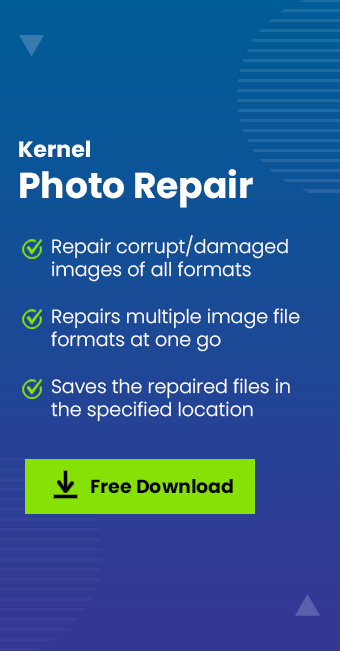Read time: 8 minutes
Encryption means encoding any document for the purpose of disabling its accessibility to persons other than the one intended to have access to it. To have access to the encrypted document, one needs to decrypt it or, in other words, decode it. In lucid language, encryption refers to blocking access to any document with a code, and decryption refers to unblocking access to the document by deciphering the code.
Similarly, encryption of JPEG photos is also meant to maintain the privacy and security of one’s photos and limit their accessibility to intended and selective people.
Sometimes, these encrypted JPEG photos get corrupted, and then, they cannot be decrypted or decoded as they have become inaccessible.
In the present blog, we are going to discuss the need for encryption, reasons for the inability to open encrypted JPEG photos, and ways to open and repair encrypted JPEG photos.
Why do we encrypt JPEG photos?
The basic and foremost aim of encrypting JPEG photos is to limit their accessibility only to intended persons. For example, the encryption of photos by celebrities provides safety to their images from meddling and inquisitive eyes. In other words, encryption helps them to block their images from those who should be kept away from them.
Further, several incidents have been reported of maliciously or accidentally publishing private images without permission. Encryption is a way of precaution against such issues.
Encryption provides added security to images stored on your computers or laptop in case your computer hard drive gets hacked or your laptop gets stolen or lost.
Also, nobody would ever like their hard work and pure and original creation to be stolen or reproduced by others anywhere without their consent. Thus, for copyright, people use encryption to watermark their digital images so that if they are reproduced, shared, or stolen without the consent of the owner, they would instead help viewers to identify their photos and their creator.
Reasons for the corruption of encrypted JPEG photos
- Corruption of encrypted JPEG photos occurs during the transfer, downloading, or processing of encrypted JPEG photo files if any interruption occurs during these processes. These interruptions can be:
- Sudden shutdown of your computer.
- Power surge.
- Crashing of the operating system.
- Bad sectors on the storage drive.
- Virus or malware.
- Ransomware attack: this encrypts and corrupts the JPEG file header and data and makes them inaccessible.
People usually collect and keep their memories and memorable moments in the form of photos on their computers, laptops, smartphones, and on the cloud.
According to InfoTrends, a market research firm, “People now take more than a trillion photos each year. Since all smartphones have limited storage data available for the purpose, of avoiding accidental damage/loss to the images, people prefer to store their images online through ‘Cloud photo services’ like, Google, Apple, Flickr, etc. The most popular among these is Google Photos, which has more than a billion users. Presently, cloud photo services are incompatible with existing encryption techniques. For example, to reduce the size of the uploaded photos at Google, the latter compresses them, which would corrupt encrypted photos, leaving them useless.”
So, there is a need to repair encrypted JPEG photos.
How to repair encrypted JPEG photos?
To repair encrypted JPEG photos, you first need to reach the photos, i.e., to get access to them. To get access to encrypted JPEG photos, you should know the password to decrypt the file.
- In case you have the password to decrypt or decode the file, then you can repair encrypted JPEG photos using a photo editor and in severe cases, using a third-party tool.
- In case you do not have the password, then you can use some online photo decryption tools meant to decrypt encrypted image files.
Let us discuss both the cases one after the other:
Scenario 1: When you know the password
Method 1: Repair damaged JPEG file using a photo editor
Photo editing software can help you fix blurriness, grains, color distortions, etc. in photos. Open the JPEG file in the photo editor, enter the password to open the file, and use the editing features to fix the issues and repair the damaged photos. Various photo editing programs you can use are Adobe Photoshop, Adobe Lightroom, Corel Paintshop, Skylum, Canava, Stencil, PicMonkey, etc.
Method 2: Repair using online JPEG repair tools
Many online image repair tools are safe and easy to use. These tools can fix damaged headers that hinder the opening of photos and make photos inaccessible. All you have to do is open the program in your browser and upload the corrupted JPEG file for repair. Just keep following the instructions being displayed on the screen during the whole process.
Method 3: Repair encrypted JPEG file with this tool
(Note: If you are searching for different ways to recover corrupted JPEG and JPG files, then the tool proves to be an intensive, yet most accessible rescue action.)
Kernel Photo Repair is a powerful tool that can repair any image format, including JPEG, JPG, BMP, GIF, RIFF, RAF, TIF, PNG, etc. It can fix all kinds of corruption and issues of inaccessibility in images of any format, irrespective of the size of the image file. It can repair images without compromising the quality of the image, no matter to what extent the damage is.
It works in three simple steps:
- Select: Select the file/image(s) you wish to repair using the ‘drag and drop’ method. You can add as many files as you wish to repair simultaneously.
- Repair: When you click on Repair, the tool starts repairing selected files, together.
- Save: Once files are repaired, the program will ask you the destination or place where you would like to save your repaired files and in which format. You can save the repaired files at the place of your choice.
The tool can repair corrupt image files as well as video files. It is an easy-to-use tool and is compatible with all versions of Windows and Windows image file formats.
Scenario 2: When you do not know the password
When you do not know the password of an encrypted JPEG photo file, then the scenario may be that your JPEG photo file has been encrypted by ransomware.
Let us understand ransomware:
As the name itself suggests, it is a way of online extortion. STOP/DJVU ransomware is a Trojan Malware that intrudes your system secretly, encrypts your files, makes the files inaccessible, and decrypts the files only when the victim pays for/buys decryption keys.
Modus operandi:
STOP/DJVU ransomware can intrude through unsafe networks. It intrudes secretly and encrypts your files, including files like PDF, DOC, JPEG, JPG, and more. Once it encrypts a file, it adds an extension, ‘.djvu’ to the file. Further, it shows ‘readme.txt’ or ‘openme.txt’ on the desktop. This contains a note of ransom and details of payment. To decrypt your files, you need to buy decryption keys from them.
Also, the virus deletes disk backups and updates Windows registry entries and other various system files, making it impossible to recover or restore the infected files.
Ransomware encrypts your files using one key, which it uses online if your system is connected to the internet; if it cannot connect to its server, then it uses one key, which is part of the malware code. In the latter case, decryption is possible.
How to decrypt ransomware-affected files?
Method 1:Isolate the affected device
When the files infested are stored in external storage, this infection may spread in the local network as well. As soon as you discover the infection, isolate the device immediately. For this, do:
- Disconnect internet connection.
- If you are using Ethernet, disconnect it.
- Disconnect your computer in all ways, from all other computers to which it is connected.
- Remove all the storage devices connected to your computer.
- Log out of the cloud account to prevent the spread of infection to cloud files.
- Uninstall your ‘cloud storage software’ till you have repaired all STOP/DJVU ransomware-infected JPEG images successfully.
Method 2: Recognize ransomware attack
Recognizing ransomware is not an easy task. Ransom message may introduce itself, which is not very common you may get a clue from the name of the ransom message, but names being generic and similar may not prove a sure-shot method. File extensions may also work if they are not generic but rather different or unique.
The use of ID ransomware websites may prove more helpful in recognizing the infection. All you need to do is upload the ransom message or infected file. It will provide the required ID.
Once you have the ID, search for any free decryption software available online and use the ID to decrypt your JPEG file.
If you do not find any such ID, then the encryption was made using the online key. It may be difficult to decrypt the file.
Method 3: Remove files infected with ransomware
Once this malware intrudes your system, it creates files at different strategically important locations. Even if you have removed the malware successfully from your system, these strategic files tend to attract the malware again. Thus, remove such files as soon as possible. To do so, follow the steps given below:
- Press together Window KEY+R at the same time.
- The Run box will open. Type the given text one by one except the 5th one. For each, in the options, look for files similar to ransomware, delete them immediately, and press ‘OK’. For the 5th one i.e., temporary folder, delete all the files.
- %AppData%
- %LocalAppData%
- %ProgramData%
- %WinDir%
- %Temp%
Method 4: Use a third-party JPEG tool
The fastest and safest method to repair and recover your encrypted JPEG photos is to use this third-party tool. It is the most intelligent solution to solve your issues expeditiously and safely without compromising the quality of recovered photos, irrespective of their number and size.
Moreover, besides the above-mentioned issues, you may also be facing different problems with your JPEG/JPG photos, like you may be trying to find out what to do when photos and images fail to open after recovery. or if your digital camera taking black picture? Fix it now with this tool.
Conclusion
In the present article, we discuss encryption and decryption of JPEG photos, the need for encryption, reasons for corruption of encrypted JPEG photos, and ransomware: what it is all about, its mode of working, its effects, and most importantly, how to combat, avoid and overcome the ransomware infection.







